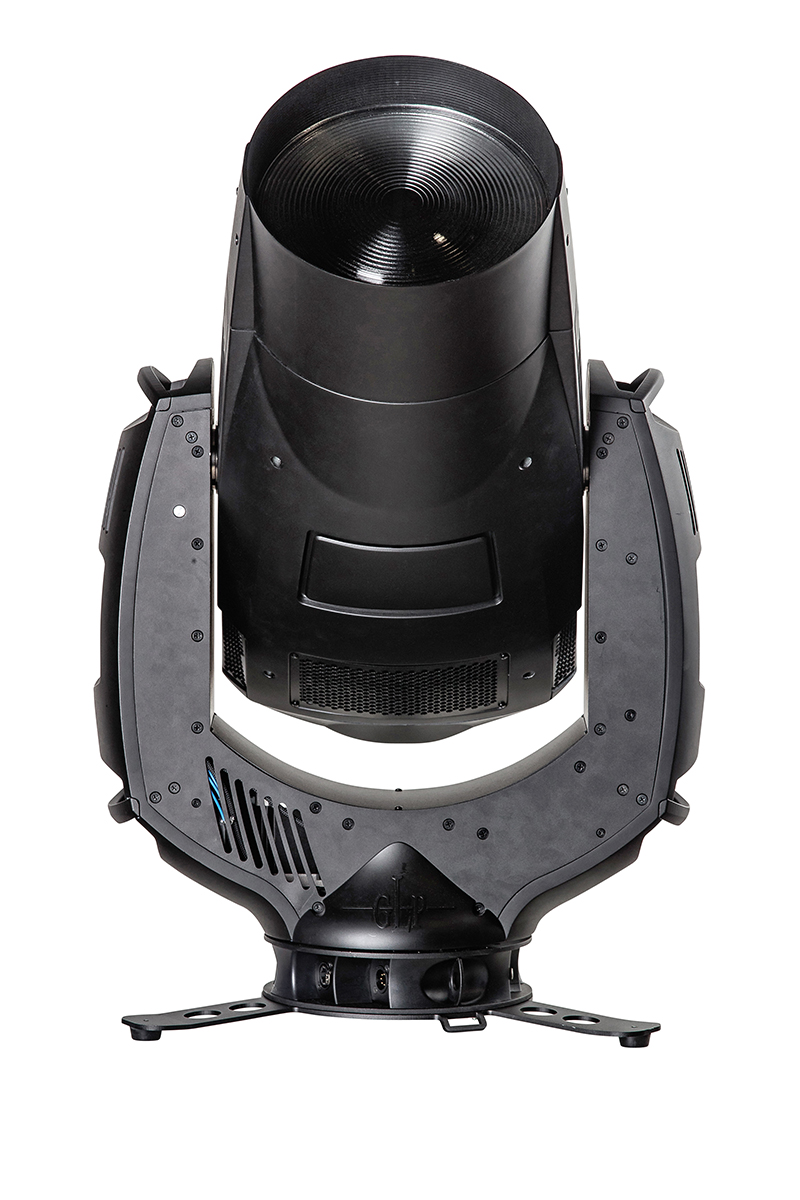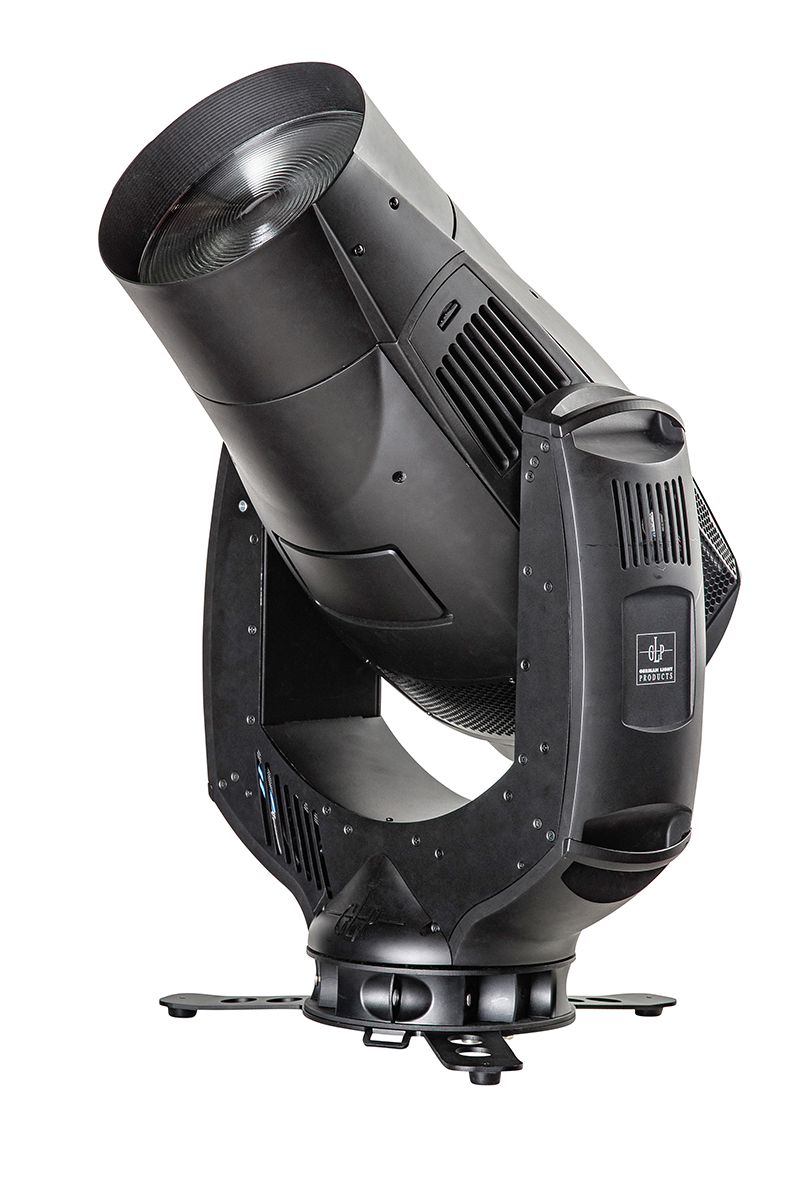
There was a time in the lighting world when all moving lights were either a hard edge unit or a wash fixture. By 2002, the Martin MAC 2000 Wash had become a staple fixture on the concert, theater, and corporate scenes. But then along came the LED pancake light and a whole range of hybrids that took its place. Any hard edge fixture that had a frost or could be softened via its zoom was considered a good substitute for a wash light. Because it really wasn’t, there were many LDs who still longed for a powerful, dedicated wash fixture. PLSN featured the latest wash lights in our Feb. 2020 Buyers Guide (page 50-52), as they have made a comeback. GLP was one company that featured a new fixture with a discharge bulb as its light source.
I got the chance to take this fixture on a test drive at the recent NAMM show in January, where its bright white beam was gathering the attention of all passersby. The light beam emitted came from a 1,400-watt Osram Lok-it 1400/PS Brilliant bulb. The Highlander itself features a 20,000 lumen output. With this flicker-free light source came a native color temperature of 6700° Kelvin, as well as a CRI of 91. Osram claims the bulb has a lamp life of 750 hours.
As with all of GLP’s movers, the Highlander is baseless. Designed to be compact, the unit can be hung in any orientation. It comes with a removable tripod base with brackets for ratchet belt attachment if necessary (think of fixtures traveling in sets). They have made it easy to carry by placing open holed handles on the top of the yoke. The fixture has an IP20 rating.
Power is connected via Neutrik True1, whilst data is connected via 5 pin XLR or Ethernet connecters, with DMX, Art-Net or sACN as available control options. The fixture utilizes 26 DMX channels for operation. The auto ranging power supply can accept any AC voltage from 100-240. The lamp can be operated at two power levels which can be adjusted in the fixture settings window during setup. At the NORMAL power setting, the lamp runs at 1400 W, while at the ECO setting the lamp is running at 1000 W. Basically, if you are running on power under 208 volts, you would place the fixture in ECO mode. At 230 volts, the fixture is using 1750 total watts. One should run them at the higher voltage for maximum efficiency.
The mechanical dimming is perfectly smooth and the user can set their own preferred dimmer curve (straight linear or slow) externally. There is a built in shutter control that comes with all sorts of strobe functions, including the usual sync and random rates with the option of adding the pulse function to either.
The Special/Control DMX channel allows the user to change fixture settings, power the lamp, and reset the fixture from the console. To apply a command on this channel, you must hold the command for a certain amount of time.
One can set the fixture to react in four different ways if no DMX signal is present, via the control panel (such as douse the lamp). Users can also adjust the already regulated fan speed from regular to high (which helps when cooling down lamps).

Beam Control
The zoom range is fairly impressive, tightening up to 5° for a fully collimated beam to emit from the extra wide aperture. It can operate fast enough to be used in a sin wave effect or reset in black. When zoomed to full the beam expands to 44°, a 7:1 zoom ratio. The front lens is a 9-inch-diameter Fresnel style, most designers prefer the large aperture at the light source on a wash fixture. There is a focus channel which is used to adjust the hot spot in the beam. One can adjust the beam from a flat field to a center hot spot that pierces through the center of the beam for that Rock and Roll look. The focus has the ability to track with the zoom.
An interior barn door system is in play via a framing system. Each blade can do a full curtain wipe across the optical path or rotate 30°. The whole mechanism can rotate ±45° in either direction. An interesting function of this framing system is the Position/Indexing (PI) mode the Highlander offers as a function if you do not want to utilize the usual tedious framing methods. It lets you insert each blade from 0-100% on one channel and tilt each blade from -30° to +30° on the next channel. This theoretically turns the framing system into an Iris function. If you use framing and the iris effect at the same time, the iris effect is overlaid on top of the framing function: in other words, you can use framing effects within the area defined by the iris.
There are no gobo or effects wheels in this wash light. GLP have designed a dedicated Wash Light with the Highlander, not an effects or hybrid type fixture.

Movement and Color
The fixture pans 670° and has 265° tilt capabilities that it covers at an above average speed for a fixture this size. There are different “Performance Modes” that allow the user to adjust the speed of the fixture from fast, to medium, to smooth. This effects the speed of all the mechanical features (movement, color wheels, zoom, and focus). The default is the Normal Mode, which offers smooth changes with little noise. The Fast Mode is suitable for rock shows where fast movement and snap cues are needed. But the fixture is louder in this mode. The last mode is the Smooth one, which optimizes the smooth slow movement, great for camera work.
The CMY color system offers some of the most saturated colors on the market. Rich, deep cyan and magenta colors make it easy to mix a deep blue, though it cuts a lot of light out. A variable color temperature flag allows the beam to go from the open 6700°K down to 2300°k for a full CTO color.
The fixture contains two color wheels which help with the output lumens on such saturated colors. The first wheel contains seven saturated colors ranging from a robust blood red to a deep blue. The other wheel is set for pastels and color correction filters. They both do half colors. I was able to get some interesting effects on the actual glass lens by putting in half colors and closing the framing shutters to slats. By default, the fixture will always take the shortest route between two colors on the wheel. This may bothersome to some LDs as the wheel may go through open white to reach its destination. This attribute can be turned off in the control panel.
At a Glance:
A Category Comeback?
Lighting designers have made their preferences clear — that the industry is still in need of a wash light utilizing a discharge bulb as its light source. If this fixture type category is indeed making a comeback, there is probably no better model to lead the charge than the Highlander.
GLP Highlander
PROS: Medium-sized wash fixture that fills a void in our business. Internal barndoors, deep saturated colors and a wide aperture are appealing to designers. Position/Indexing system that makes the framing system perform like an Iris mechanism. Baseless.
CONS: Could use an available PC lens option for more output lumens
FEATURES
- Osram Lok-It 1400/PS Brilliant Light Source (1400W)
- Color System: CMY flags; two color wheels
- Color Temp Range: 2300-6200°K
- Full Framing system
SPECS
- Fixture Wattage: 1750W
- Zoom Range: 6°-44°
- CRI: 90
- Lamp Life: 750 hours
- Weight: 65 lbs.
- Size: 19.4 x 11.4 x 30.5”
- MSRP: $14,499
Manufacturer: GLP
More Info: www.germanlightproducts.com


